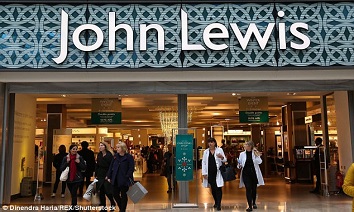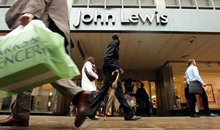John Lewis Releases Annual Summary
John Lewis has continued to outperform the market in uncertain trading conditions, with gross sales up 2.8% to £4.56bn (4.4% on a 52 week basis). To ensure that customers can shop whenever and however they want, John Lewis has continued to invest in its shops, website and infrastructure. Operating profit was down 0.1% to £250.2m (up 0.2% on a 52 week basis), but excluding property profits it was up 0.4% (up 0.7% on a 52 week basis), held back by restructuring costs and absorbing a greater share of centrally incurred functional costs.
John Lewis has continued to outperform the market in uncertain trading conditions, with gross sales up 2.8% to £4.56bn (4.4% on a 52 week basis). To ensure that customers can shop whenever and however they want, John Lewis has continued to invest in its shops, website and infrastructure. Operating profit was down 0.1% to £250.2m (up 0.2% on a 52 week basis), but excluding property profits it was up 0.4% (up 0.7% on a 52 week basis), held back by restructuring costs and absorbing a greater share of centrally incurred functional costs.

In line with changing customer expectations, John Lewis is redesigning shops to offer additional services and instore experiences, while delivering convenience and added flexibility through its online channels.
Of total merchandise sales, shops contributed 67% while online represents 33%. On a 52 week basis, online sales increased by 17.3%, and while sales in shops were down 1.0%, their role in the omnichannel journey is demonstrated by the fact that more than three-quarters of John Lewis customers made a purchase from one of its shops, and online sales increase in catchment where it opens a new shop. Click & collect orders grew by 11% and account for 53% of online orders, while sales through mobile devices increased by 34% and smartphones by 86%.
John Lewis shops are increasingly becoming places of inspiration and leisure destinations. In Birmingham, the retailer opened its first full-line department store for four years with brand new concepts including the fashion-led lifestyle concept loved&found and the first ever &Beauty spa. John Lewis invested £14m in a brand new Home floor at John Lewis Oxford Street, and across the estate its shops continued to diversify with further third-party catering and service concepts opening this year.
All product areas saw gross sales growth and market share increases, reflecting the strength of our offer. On a 52 week basis, sales in Home were up by 4.1%. The retailer's in-house collections including the House and Croft ranges complement the best of design from the industry, and John Lewis is building its personalisation offer to allow customers to create bespoke interiors. This year it also launched US brand West Elm at our Oxford Street shop.
The retailer continued to invest in its distribution infrastructure. When a new distribution centre opens at Magna Park in Milton Keynes during 2016, for the first time John Lewis will be able to combine online orders from across our product assortment into one site, meaning that customers will receive fewer separate parcels when they order online.
Overseas the retailer is continuing to build a premium John Lewis brand through shop-in-shops, where our successful ventures in Singapore, the Philippines and South Korea will be joined by sites in Dubai and Holland announced this year.
The my John Lewis programme increased members by 32% to 1.8 million customers, and customer numbers continued to grow.
John Lewis Financial Services continues to play an important role in the business, and commissions grew by 22%.
In 2016, John Lewis will open two shops in Leeds and Chelmsford, two major distribution centres in Milton Keynes and invest in significant changes to its technology infrastructure.
Capital investment in 2015/16 was £493.8m, a decrease of £177.1m (26.4%) on the previous year. However, John Lewis has continued to increase its investment in IT and distribution, which now represents 50% of its total capital investment.
At 30 January 2016, net debt was £372.5m, a decrease of £349.2m (48.4%) in the year. The reduction reflects the focus on cash generation driven by good cost control, the reduction in capital investment and the completion of the sale of John Lewis' Clearings building.
Net finance costs on borrowings and investments increased by £8.5m (16.1%) to £61.3m, reflecting additional finance costs on the £300m bond issued in December 2014. After including the financing elements of pensions and long service leave and non-cash fair value adjustments, net finance costs decreased by £3.0m (3.0%) to £96.6m.





 沪公网安备31010402003309号
沪公网安备31010402003309号



